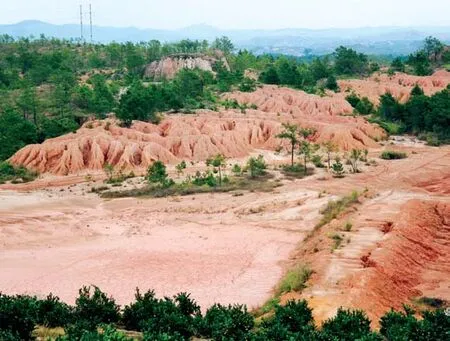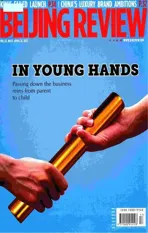Rectifying Rare Earth
2012-10-16ChinasetsuprareearthassociationtospurhealthydevelopmentoftheindustryByLiuXinlian
China sets up a rare earth association to spur healthy development of the industry By Liu Xinlian
Rectifying Rare Earth
China sets up a rare earth association to spur healthy development of the industry By Liu Xinlian

SCAR ON THE EARTH: Unauthorized mining of rare earth makes the land bare, allowing deserti fi cation to spread in Xinfeng, Jiangxi Province
Disputes surrounding China’s rare earth industry are hardly rare. Domestically,the industry was plagued by environmental pollution and fragmented mining operations. Internationally, China’s implementation of an export quota system on rare earth has triggered trade frictions.
A newly established nationwide rare earth association may become a helping hand to the government in solving these disputes.
On April 8, the China Rare Earth Industry Association was set up in Beijing. The association, consisting of 155 members that include industry giants Aluminum Corp. of China(Chalco) and China Minmetals, was formed to promote sustainable and sound development in the sector, said Su Bo, Vice Minister of Industry and Information Technology(MIIT) which governs the association.
The establishment of the association is considered a move to accelerate consolidation of the sector and help deepen international communication and properly handle trade disputes.
But the association will not be a cure-all remedy. Analysts doubt whether the association could produce a unified voice with 155 members and consolidation efforts may not pay off as expected because of too many different interest concerns.
Timely launch
The establishment of the rare earth industry association is the culmination of widespread market speculation that China would come up with an organization to monitor and regulate the sector’s activities, especially rampant illegal explorations.
In order to regulate the largely unauthorized exploration for rare earths that has led to increased smuggling operations, China adopts production caps and export quotas.
“We cannot follow the path of predatory mining in the rare earth industry any longer,nor can we continue to sell rare earth into domestic and foreign markets at unreasonably low price,” said Zhang Weichen, an expert of the Chinese Academy of Land and Resources Economics.
But China’s efforts to protect its rare earth industry and environment seemed to irritate international buyers. On March 13, China received negotiation requests put forward by the EU, United States and Japan on the export management measures of rare earth, wolfram,and molybdenum under the WTO’s disputesettlement system.
The establishment of the association is the result of the case fi led by the EU, United States and Japan with the WTO,Du Shuaibing, an analyst with Beijingbased Baiinfo, an industrial research agency, told theGlobal Times. Trade associations in other countries are playing a leading role in interacting to the common benefit of the whole industry and providing a uniif ed voice to lobby.
The establishment of the association is also considered a move to accelerate consolidation of the sector.
“Developing an industrial pattern led by several big businesses via merger and acquisition (M&A)and restructuring has become the direction of reform in the rare earth industry,” said Lin Boqiang, Director of the China Center for Energy Economics Research in Xiamen University.
M&As and restructuring have been in full swing this year, led by Chalco, China Minmetals,China Nonferrous Metals Mining, Baotou Steel Rare Earth and Ganzhou Rare Earth.
Environmental consideration
This year China will focus on cracking down on illegal mining, production and smuggling of rare earth, said Su at the launching ceremony of the association. China will not accept new application of mining of rare earth resources. Mining and smelting enterprises will no longer be allowed to expand their production capacity.
“The association will not only do its best to explain the country’s rare-earth policies but also take the responsibility of protecting the environment,” Su said.
Rare earth minerals are a group of 17 elements which are mainly used in manufacturing hi-tech products, such as solar panels,electric or hybrid vehicles, wind turbines,consumer electronics and other clean energy technologies.
Of fi cial statistics from the MIIT showed that China’s rare earth output account for nearly 95 percent of the global total, but its reserves only account for about one third of the total.
Since rare earth elements are found dispersed in low concentrations and costly to extract, the mining methods are devastating to nature and the damage is irreversible.
A traditional mining process will eradicate trees and grass fi rst and peel off topsoil.What’s more, wastewater from the chemical reaction contains ammonia nitrogen and heavy metals, which are extremely harmful to people’s health and the environment.
China has been paying a hard price exploiting its rare earth resources. Jiangxi Province, rich in rare earth minerals, earned 32.9 billion yuan ($4.89 billion) from this industry last year, but it has to spend 38 billion yuan ($6.03 billion) to tackle the environmental pollution in Ganzhou, a city in the province.
Large groups of unauthorized miners are making the pollution problem worse. The state-run companies who are under tough environmental regulation only take up a small part of the rare earth productivity, but many small, unauthorized groups are off the limit.
Illegal mining operations and smuggling also allowed more resources to enter the global market. This partly explained why China, as the world’s predominant rare earth producer, does not have the pricing right even after paying extremely high cost.
Liu Shuchen, a researcher at the Information Center of the Ministry of Land and Resources, said that for more than a decade, the price of rare earth has been going downward, a sharp contrast to the climbing prices of resource products such as iron ore and coal. In 2009, the export price of China’s rare earth was only about 60 percent of the price in the 1990s.
Not a panacea
Even though the association was founded to promote international trade dispute settlement, the chance of winning the WTO complaint was even considered slim for the association itself.
“We might lose the WTO complaint,”said Gan Yong, president of the association,at the launching ceremony.
“China’s export quota control aims to protect its own industry and environment,which was misinterpreted as intervening in the market by Western countries,” Du said.
What has happened in China’s steelmaking industry did not give analysts too much con fi dence in the rare earth industry.
China Iron and Steel Association has made various efforts to provide a unified voice in international iron ore pricing negotiation in the past few years, but China still has to face rising prices despite being the biggest iron ore consumer in the world.
“The problem in China’s steel industry is that the members of the iron and steel association failed to provide a uni fi ed voice because of different interest concerns,” Du said. He believed that the rare earth industry association may face the same problem.
In addition, consolidation efforts may not pay off as expected.
“Consolidating the industry is far from just setting up an association,” said Zhang Anwen, Deputy Secretary General of the Chinese Society of Rare Earths and an initiator of the association. “It requires concerted efforts from all parties concerned.”
“It will take a long time to achieve the goal of forming a rare earth industry structure led by major companies and consolidating more than 80 percent of the country’s rare earth mining assets into three largest rare earth ion producers in south China,” Gan said.
Rare earth producers in south China are similar in size and competitiveness, and local governments are loath to support crossprovince mergers, said Zhang Anwen. So it is much more dif fi cult to push forward consolidation in south China and almost impossible to form two to three industry behemoths as planned by the MIIT.
“The role of the association should be played in coordinating the interests of various rare earth enterprises, avoiding vicious competition and forming the uni fi ed stand on export pricing, rather than pushing forward consolidation as the government’s will,”said Bai Ming, Associate Director of the Department of International Market Studies at the Chinese Academy of International Trade and Economic Cooperation.
